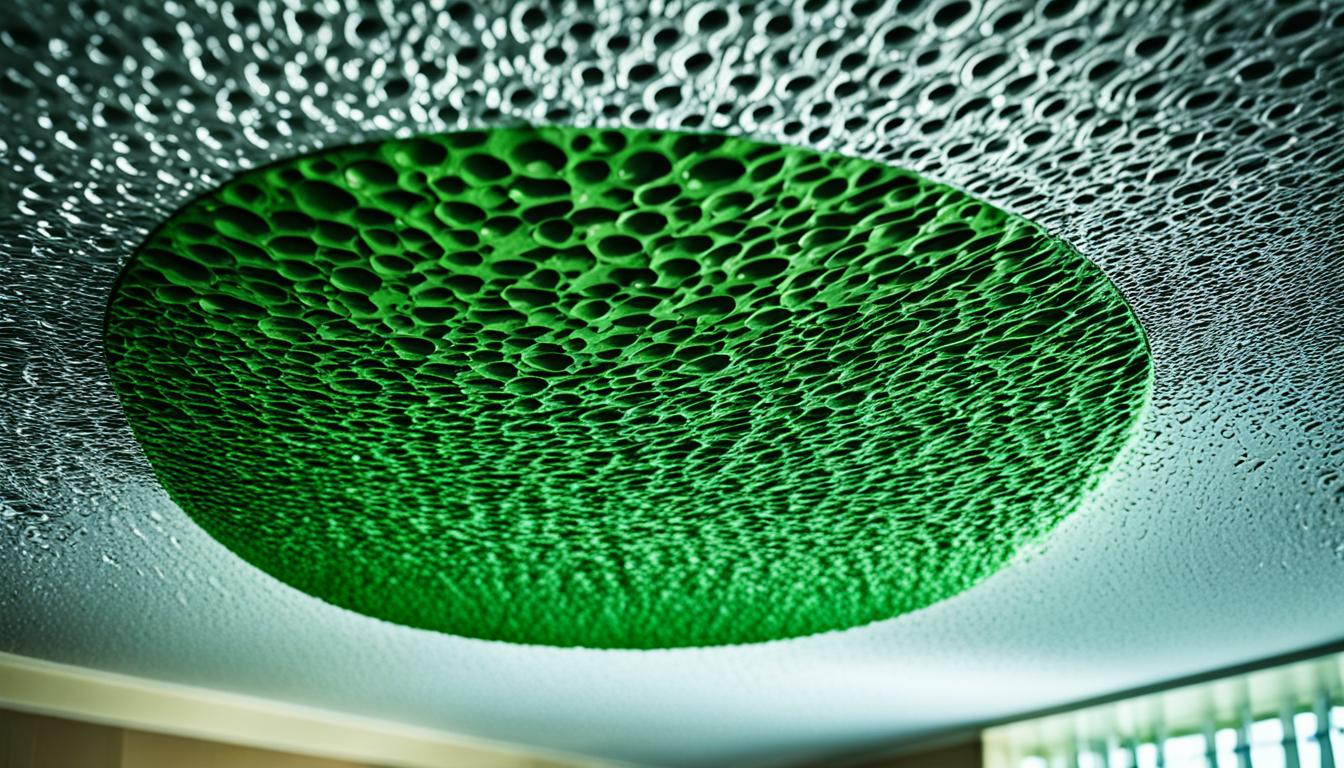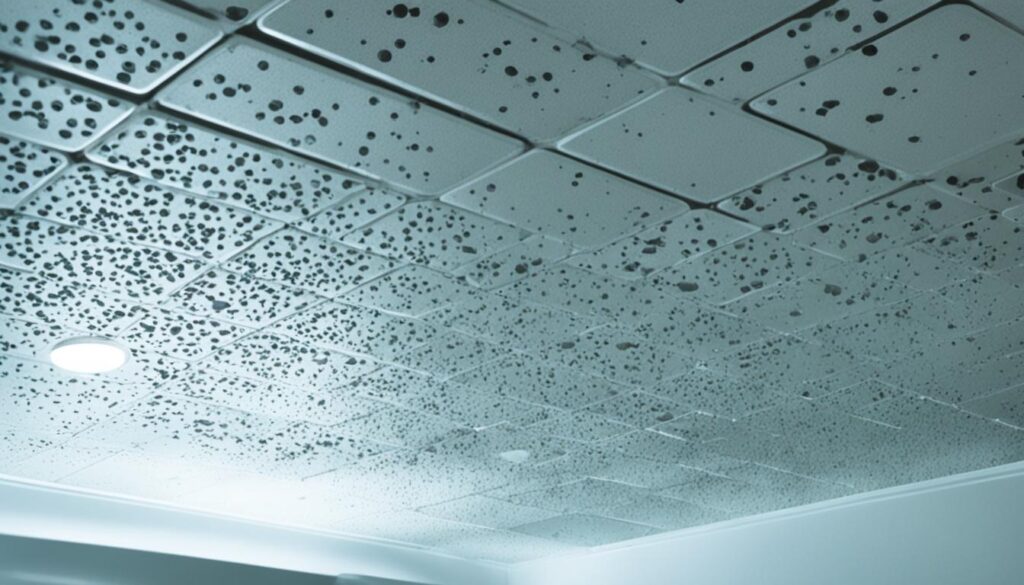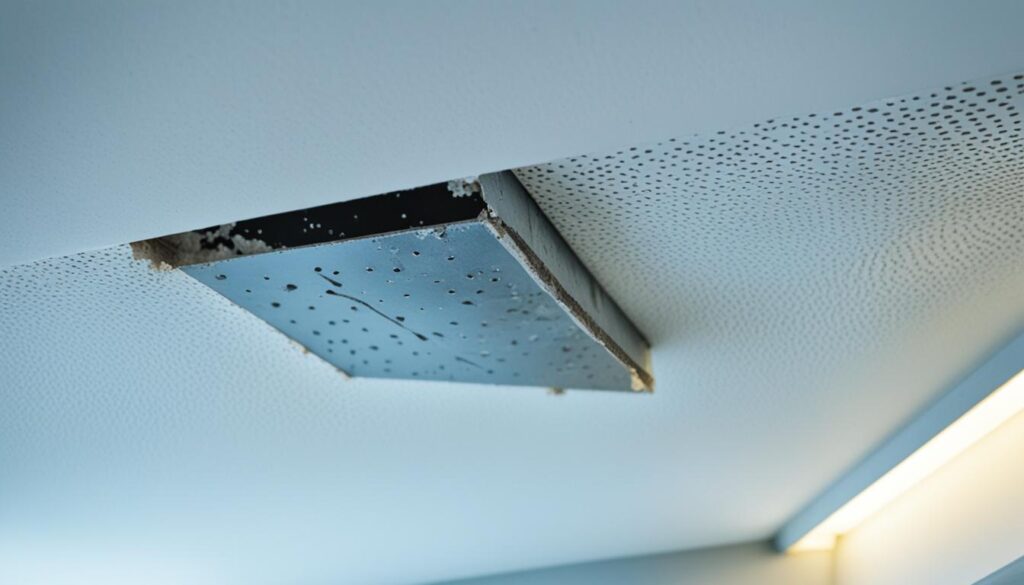
Mastering the Art of Mold in bathroom ceiling
Welcome to our comprehensive guide on mastering the art of dealing with mold in the bathroom ceiling. Mold growth in the bathroom is a common issue that can lead to health problems and damage to your home. In this section, we will provide you with expert advice on identifying, preventing, and effectively removing mold to ensure a clean and healthy bathroom environment.
Key Takeaways:
- Identify the signs and symptoms of mold in your bathroom ceiling for early detection
- Take proactive measures such as controlling moisture and improving ventilation to prevent mold growth
- Learn effective techniques for removing mold, whether through DIY methods or professional assistance
- Stay vigilant and regularly inspect your bathroom for any signs of mold
- By following these tips, you can enjoy a mold-free bathroom and a healthier living environment
Understanding the Signs and Symptoms of Mold in Bathroom Ceiling
When it comes to mold in your bathroom ceiling, early detection is key to preventing further damage and ensuring a healthy living environment. In this section, we will explore the signs and symptoms that can indicate the presence of mold. By familiarizing yourself with these indicators, you can address the issue promptly and effectively.
Visual Inspection Process
Conducting a visual inspection is a crucial step in identifying mold growth in your bathroom ceiling. Look out for the following:
- Discolored patches or spots: Mold growth often appears as black, green, or brown patches on your ceiling.
- Peeling or bubbling paint: Moisture caused by mold can cause the paint on your ceiling to peel or bubble.
- Water stains: If you notice water stains or discoloration on your ceiling, it could be a sign of an underlying mold problem.
- Surface texture changes: Mold growth can lead to changes in the texture of your ceiling, making it appear rough or uneven.
By thoroughly examining your bathroom ceiling for these visual cues, you can begin to assess the extent of the mold growth and take appropriate measures for removal.
Musty Odor: A Telltale Sign
“A strong musty odor in your bathroom is often a red flag for mold growth. This distinctive smell is caused by the release of microbial volatile organic compounds (MVOCs) by mold colonies. If you detect a persistent musty odor, it is crucial to investigate further and address any underlying mold issues.”
While visual inspection can provide valuable insights, relying solely on it may not be sufficient. Musty odors are a reliable indicator of the presence of mold, even if it is not readily visible. If you notice an unpleasant smell in your bathroom that persists despite regular cleaning, it is essential to take prompt action.
Identifying Different Types of Mold Growth
Mold can manifest in various forms, each with its characteristics and potential health implications. Here are some common types of mold that you may encounter in your bathroom:
| Mold Type | Appearance | Potential Health Effects |
|---|---|---|
| Aspergillus | Gray or black patches | Allergic reactions, respiratory issues |
| Stachybotrys | Black or dark green slimy texture | Severe allergic reactions, respiratory problems |
| Cladosporium | Olive-green or brown appearance | Nasal congestion, skin irritation |
| Penicillium | Green or blue-green fuzzy texture | Allergic reactions, respiratory issues |
Identifying the type of mold in your bathroom ceiling can aid in developing an appropriate removal plan and understanding potential health risks.
Now that you are familiar with the signs and symptoms of mold, as well as how to visually inspect your bathroom ceiling and identify different types of mold growth, you are equipped to take proactive steps in tackling this issue. In the next section, we will explore preventive measures to minimize the risk of mold development in your bathroom.

Proactive Measures for Preventing Mold in Bathroom Ceiling
To effectively prevent mold growth in your bathroom ceiling, it is crucial to take proactive measures that address the underlying causes. By implementing these strategies, you can maintain a mold-free environment and safeguard the health of your household.
Moisture Control Techniques
One of the primary factors contributing to mold growth is excessive moisture. To combat this, it is essential to implement effective moisture control techniques:
- Regularly check for and fix any plumbing leaks or water damage.
- Keep the bathroom well-ventilated during and after showers by using an exhaust fan or opening windows.
- Wipe down wet surfaces, such as shower walls and faucets, to remove excess moisture.
- Use moisture-absorbing products like dehumidifiers or moisture-control packets.
Optimal Ventilation Strategies
Proper ventilation plays a crucial role in preventing mold growth by reducing humidity levels in the bathroom. Consider these ventilation strategies:
- Ensure your bathroom has adequate ventilation, such as a properly functioning exhaust fan.
- Run the exhaust fan for at least 30 minutes after showering to remove excess moisture.
- Open windows or use a portable fan to enhance air circulation in the bathroom.
Sealing Cracks and Leaks
Small cracks and gaps in the bathroom ceiling can provide entry points for moisture, leading to mold development. Take the following proactive measures:
- Regularly inspect and seal any cracks in the ceiling, especially around light fixtures and vents.
- Ensure proper insulation in your home to prevent condensation and moisture buildup.
- Repair any leaks promptly in the roof or plumbing systems to prevent water infiltration.
By implementing these proactive measures, you can effectively control moisture, improve ventilation, and seal potential entry points, significantly reducing the likelihood of mold formation in your bathroom ceiling.
Now that you have learned about these preventive techniques, let’s explore effective removal techniques for mold in the bathroom ceiling in the next section.
Effective Removal Techniques for Mold in Bathroom Ceiling
When it comes to removing mold from your bathroom ceiling, there are various techniques you can employ. In this section, we will explore both DIY methods and the importance of seeking professional assistance for effective mold removal.
DIY Methods
If you prefer a hands-on approach and have a smaller mold issue, DIY methods can be a cost-effective solution. Here are a few effective techniques to consider:
- Bleach Solution: Create a mixture of one part bleach to ten parts water. Apply the solution to the affected areas using a sponge or spray bottle. Allow it to sit for at least 15 minutes before scrubbing off the mold.
- Vinegar: Vinegar is a natural and non-toxic cleaner that can help eliminate mold. Spray undiluted white vinegar onto the moldy surfaces and let it sit for an hour. Scrub the area with a brush and rinse with water.
- Baking Soda: Make a paste using baking soda and water. Apply the paste to the moldy areas and scrub gently with a brush. Rinse thoroughly afterward.
Remember to wear protective gear, such as gloves and a mask, when using DIY removal methods. While these techniques can be effective for smaller mold problems, they may not be suitable for larger or more extensive infestations.
Professional Assistance
For larger mold issues or if you are unsure about tackling the removal yourself, it’s best to seek professional assistance. Experienced mold remediation professionals have the knowledge, tools, and expertise to handle even the most challenging cases.
Professional mold removal services can provide:
- Thorough Inspection: Professionals will conduct a comprehensive assessment to identify the extent and cause of the mold growth.
- Safe Removal: Using state-of-the-art equipment and techniques, they will safely remove the mold without causing further contamination.
- Preventative Measures: Professionals can advise on measures to prevent future mold growth, such as improving ventilation and addressing moisture issues.
While professional assistance may come at a cost, it ensures a thorough and lasting solution to your mold problem, giving you peace of mind and a healthier bathroom environment.

“Seeking professional assistance ensures a thorough and lasting solution to your mold problem, giving you peace of mind and a healthier bathroom environment.”
Conclusion
In conclusion, mastering the art of dealing with mold in the bathroom ceiling requires a combination of identification, prevention, and effective removal techniques. By staying vigilant, implementing proactive measures, and seeking professional help when needed, you can successfully conquer this common challenge.
Breathe easy again and enjoy a mold-free bathroom environment for years to come. Remember, for the best mold assessment services in Miami, contact Fix Mold Miami at 305-465-6653.




